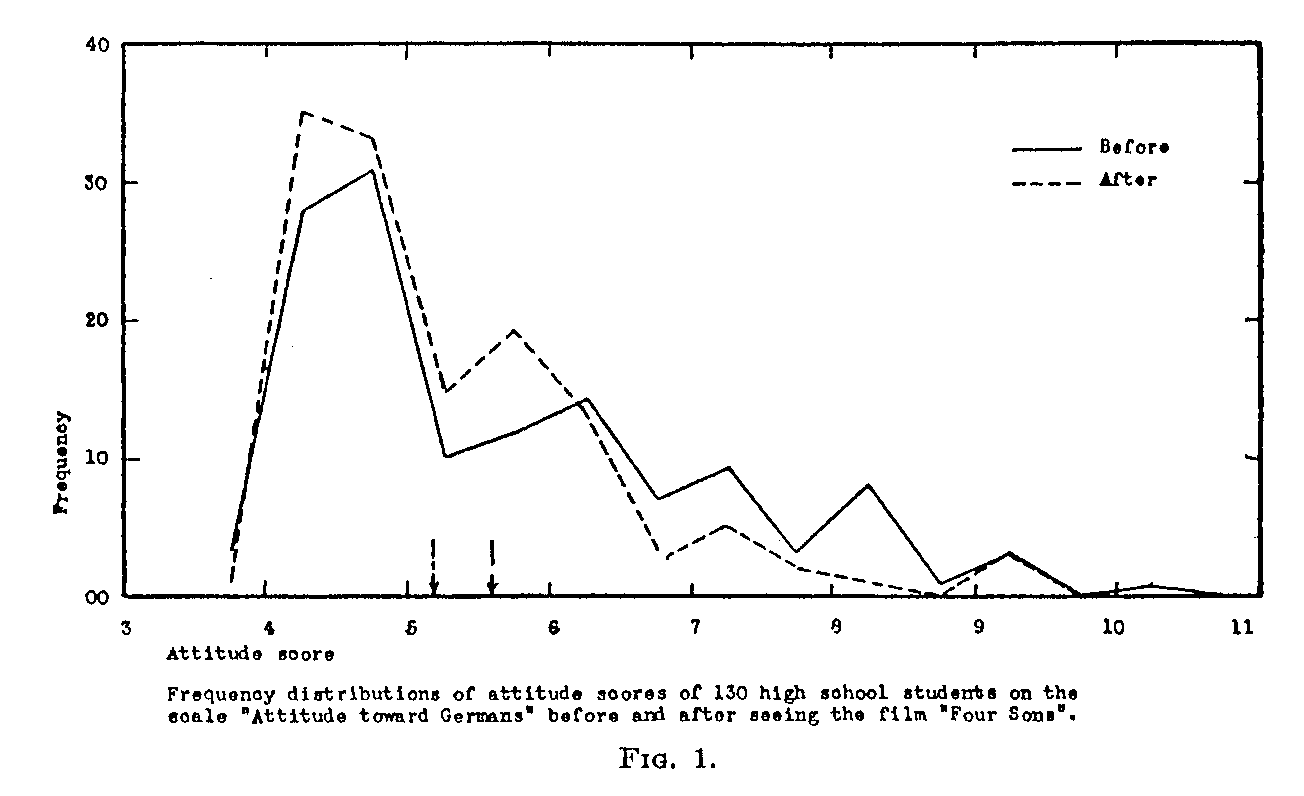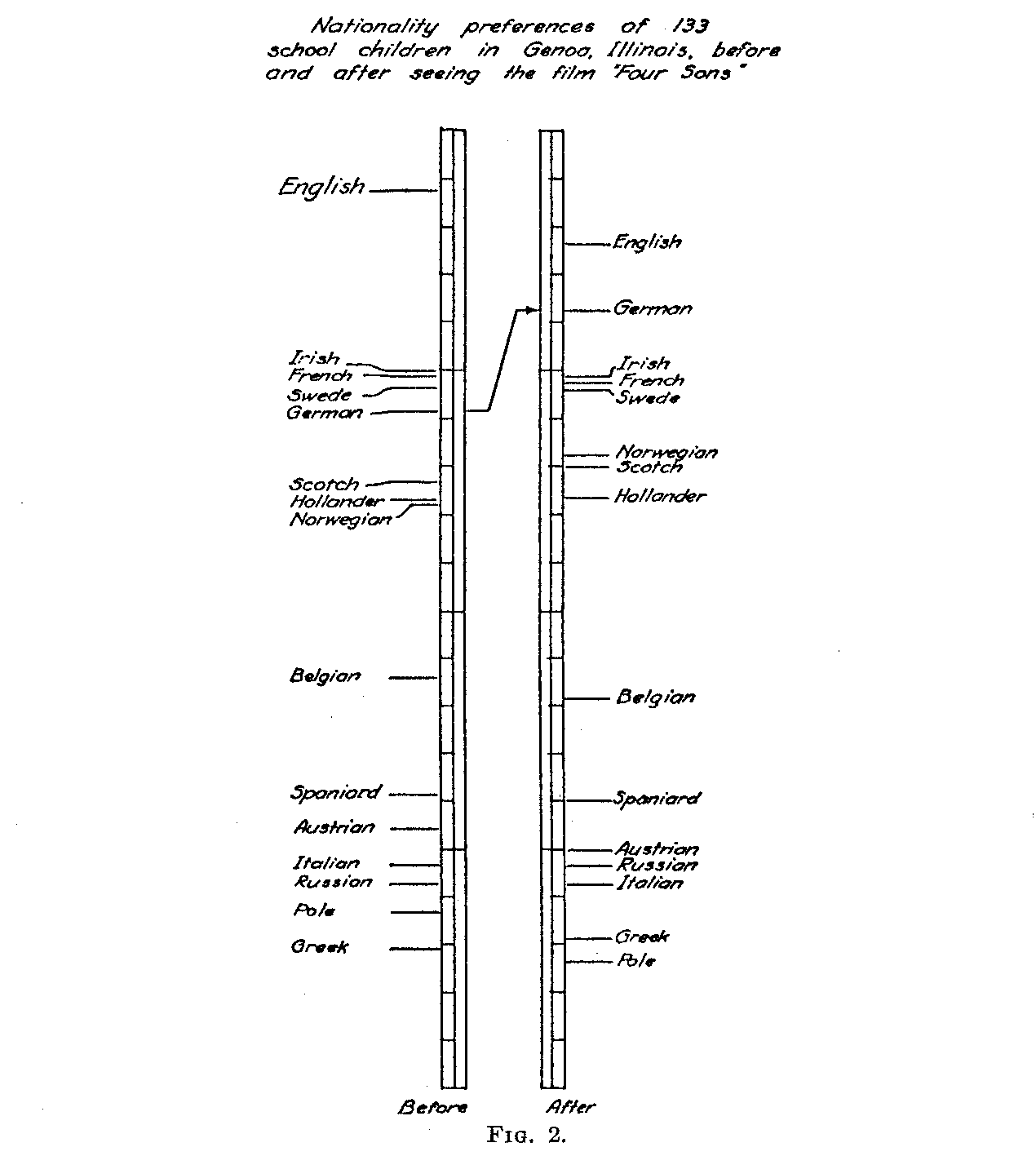The Effect of a Motion Picture Film on Children's Attitudes Toward Germans
Ruth C. Peterson and L. L. Peterson
The University of Chicago
This is one of several experiments that have been planned for the purpose of investigating the effect of motion pictures on the social attitudes of child en. This major problem takes several forms, each of which is the object of several parallel experiments. The present study was undertaken o determine whether the picture "Four Sons" had any measurable .effect on the attitudes of high school children especially as regards heir attitude toward the Germans and also as regards their attitude toward war.
The general plan for this experiment was similar to that of several other experiments in this study. The children were given certain schedules to be filled in which were intended to measure their attitudes toward Germans and toward war. Some time later they were shown the film "Four Sons." The morning after seeing the film they were again asked to fir in schedules similar to the first set. By this arrangement it was possible to ascertain whether the moving picture had changed the attitudes of the children.
The experiment was carried out in Genoa, Illinois, on one hundred thirty-three high school students.[1] They filled in the first set of schedules on April 17, 1930. They were shown the film "Four Sons" in the Genoa theatre on April 29, 1930. The following day in the high school the filled in a duplicate set of schedules. We shall compare the first and second set of schedules in order to ascertain the effect of the film on the attitudes of the children. Genoa, Illinois, is a
( 242) town with population of about 1200, and the experimental group consisted of almost the entire high school. The children in the experimental group were in Grades VII to XII inclusive.
Three schedules were filled in twice by the students. These schedules were
(1) a statement scale for measuring attitude toward the German people, (2) a
paired comparison schedule of nationality preferences, and (3) a statement scale
for measuring attitude toward war. These schedules were as follows.
A STUDY OF ATTITUDE TOWARD GERMAN PEOPLE
Write your name here ______________________________
Boy or girl ______Age ____ Grade _____
Father born in ___________ Mother born in _______________
(Name of Country) (Name of Country)
This is a study of attitudes toward German people. On the other side of this page you will find a number of statements expressing different attitudes toward the Germans.
√ Put a check mark if you agree with the statement
X Put a cross if you disagree with the statement
Try to indicate either agreement or disagreement for each statement. If you simply cannot decide about a statement you may mark it with a question mark.
This is not an examination. There are no right or wrong answers to these statements. This is simply a study of people's attitudes toward German people. Please indicate your own convictions by a check mark when you agree and by a cross when you disagree.
√ Put a check mark if you agree with the statement
X Put a cross if you disagree with the statement
( 4.6) 1. The Germans as a race are very pleasant people.
( 9. 1) 2. I'm prejudiced against people of German descent.
( 6.4) 3. German people are no better and no worse than any other people.
( 1.8) 4. I admire the German people unreservedly.
(12.3) 5. The German people are the most despicable people in the world.
( 4.1) 6. Some of our best American citizens are of German descent.
( .7) 7. The German people are the finest in the world.
(10.6) 8. The German soldiers were, almost without exception, cruel and brutal.
( 8.4) 9. Germans are slow and unimaginative.
( 3.7) 10. The more I know about the German people the better I like them.
(11.5) 11. If Germany had been wiped out by the war the world would be better off.
( 7.4) 12. I don't object to German people but I don't like the German Government.
( 4.8) 13. The German people were not responsible for and did not want war.
( 9.7) 14. I don't trust the Germans.
( 9.1) 15. The German military officer is typical of the German people.
( 9.0) 16. German parents are harsh to their children.
(11.9) 17. I hate all the Germans.
( 243)
( 4.0) 18. The ran and file of the German army were kindly admirable young men.
(2.7) 19. The Germans are the most desirable class of immigrants.
(2.4) 20. I'd rather have my sister marry a German than any other foreigner.
( 5.7) 21. The arrogance of the German officer is not typical of the German people.
(7.0) 22. I have no particular love nor hate for the Germans.
(10.9) 23. There is nothing about Germans that I could ever like.
( 7.8) 24. I suppose Germans are all right but I've never liked them.
( 3.0) 25. German home life is ideal.
(10.4) 26. The people of Germany are gluttonous, militaristic and overbearing.
( .5) 27. Germans are superior to any other nationality.

In front of each of the above statements is recorded its scale value. These scale values are of course omitted from the schedules actually used with the subjects. The score of each subject is the median scale value of all the statements he has endorsed.[2]
In Figure 1 we have drawn two frequency distributions to show the effect of the film. The two mean scores are shown to be 5.6 before seeing the film and 5.2 after seeing the film. This is a shift
( 244) in the direction of friendliness toward the Germans. The difference between these two mean scores is .38; σl = 1.43 and σ2 = 1.11. The probable error of the difference is 0.0708 so that the ratio of the difference to the probable error is 5.37. We seem to be justified therefore in concluding that the film "Four Sons" had a significant effect in making children more friendly toward the Germans. It is of some interest to note the correlation between the scores before and after seeing the film. This correlation was +.586. This correlation is determined in part by the reliability of the scale and in part by the fact that the effect of the film was of course not the same for all children.
A statement scale for measuring attitude toward war was also given to these children before and after seeing the film. The scale was adapted from the scale published by the University of Chicago Press. The adaptation was made by simplifying the statements so as to make them more suitable for school children. This scale showed a slight shift in the direction of pacifism but the shift was not large enough to be trustworthy when compared with the probable errors of the mean scores.
In addition to the statement scales the children were also given a paired comparison schedule of nationality preferences before and after seeing the film. The instructions for this schedule were as follows.
A STUDY OF NATIONALITY PREFERENCES
Write your name here __________________________
Boy or girl __________ Age ______ Grade ______
Father born in ___________ Mother born in ___________
(Name of Country) (Name of Country)
This is a study of attitudes toward nationalities. You are asked to underline the one nationality of each pair that you would rather associate with. For example, the first pair is:
Englishman-Norwegian
If, in general, you prefer to associate with Englishmen rather than with Norwegians, underline Englishman. If you prefer, in general, to associate with Norwegians, underline Norwegian. If you find it difficult to decide for any pair, be sure to underline one of them anyway. If two nationalities are about equally well liked, they will have about the same number of underlinings in all of the papers. Be sure to underline one of each pair even if you have to guess.
Englishman-Norwegian
Swede-Belgian
Russian-Norwegian
Norwegian-Italian
Pole-Russian
etc.
( 245)
The complete schedule contains a comparison of every nationality in the list with every other nationality. There were fifteen nationalities in the list. This device is quite sensitive in revealing affective values and by means of the law of comparative judgment the scale

value of each nationality was determined. The detailed procedures for these calculations are not here given because they have been previously described.[3]
(246)
In Figure 2 we have shown the scale values for all these nationalities before and after seeing the film. It is clear that the largest shift in scale value is found for the Germans. This particular shift is indicated by the arrow in the figure. It shows quite clearly that the film made the children more friendly toward the Germans. The shifts in scale value for the other nationalities are smaller and most of them are of the order of magnitude which would be expected by the chance errors in the proportions by which the scale values were determined.
This study in conjunction with several others of the same kind with different
films shows quite conclusively that the social attitudes of children are
affected in a measurable way by motion picture films and that international
attitudes can be guided by the films. The permanence of the effect of films is
being investigated as a separate study in which several attitude scales and
comparison schedules have been given to the experimental groups after an
interval of four or five months.